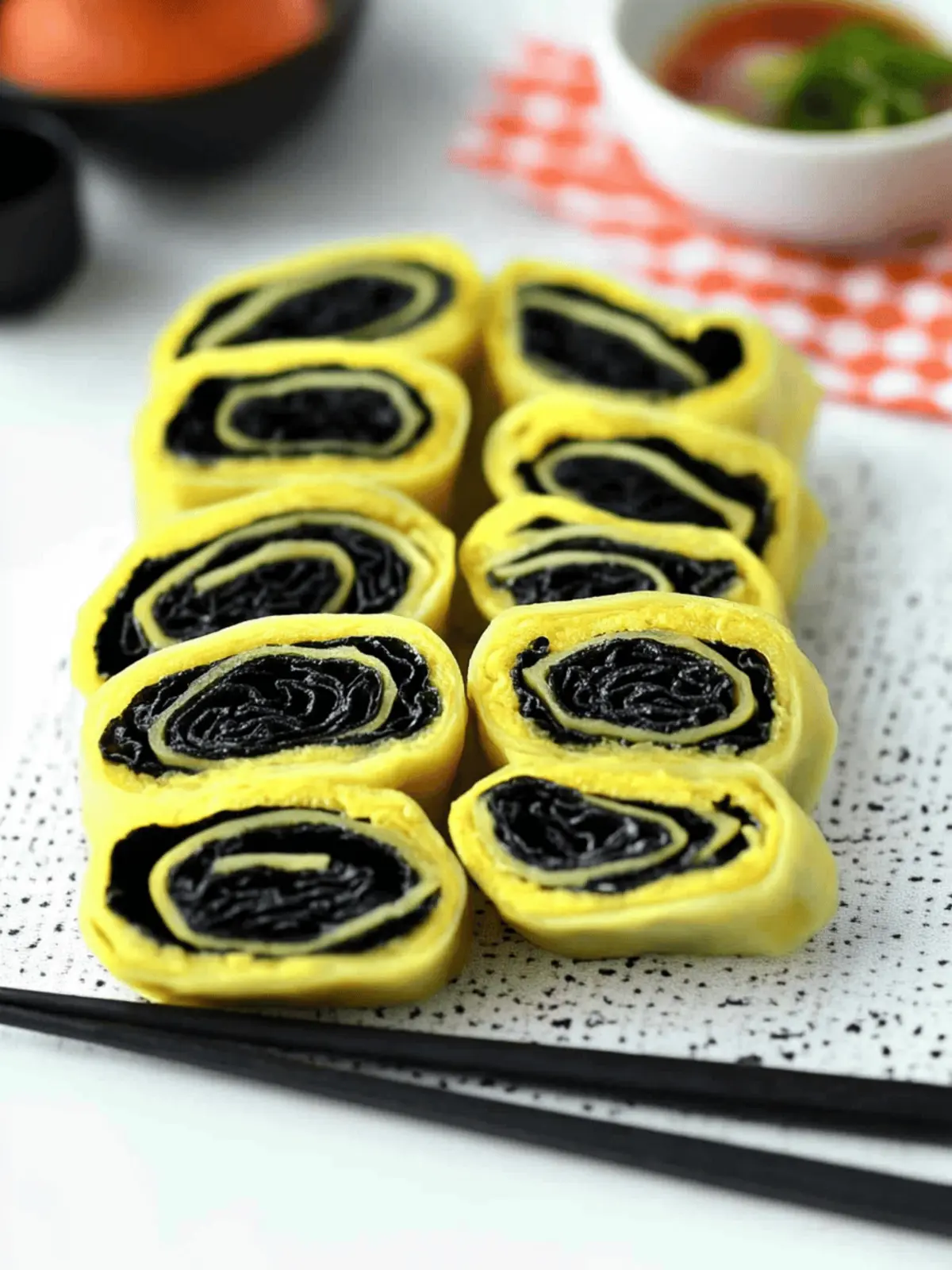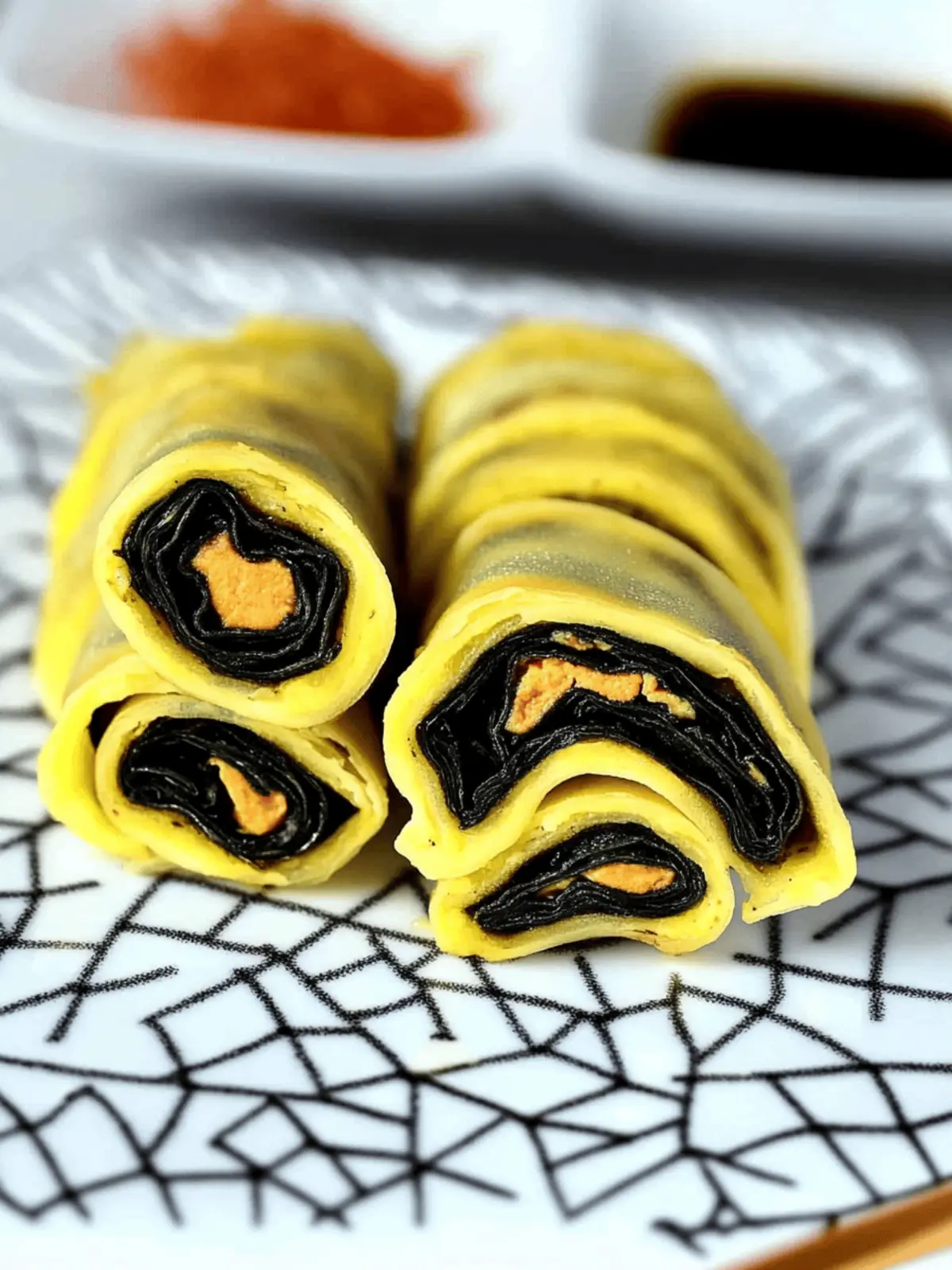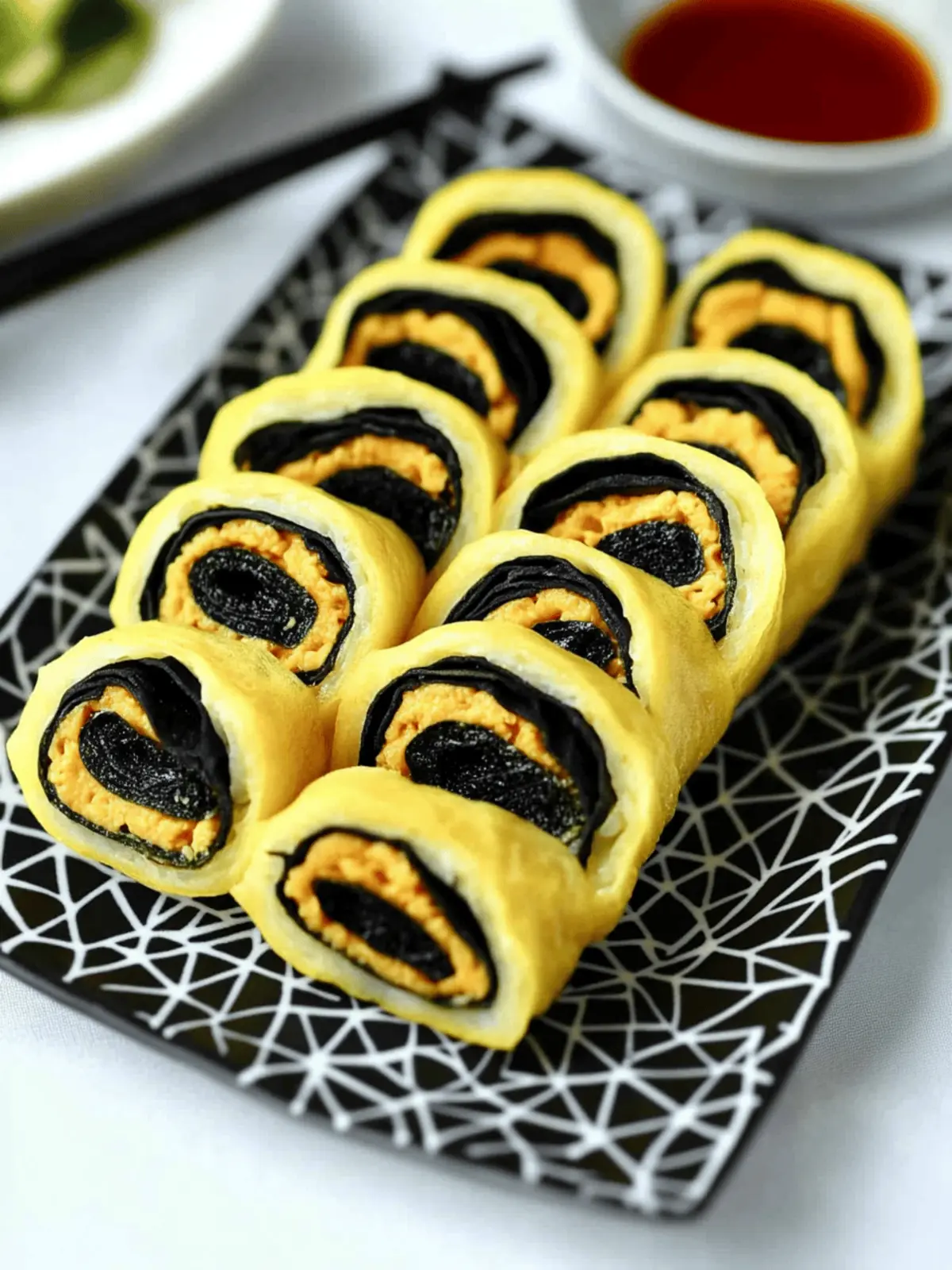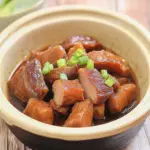There’s something truly delightful about a dish that transports you straight to a bustling market in Seoul. That’s exactly what happened to me when I stumbled upon the idea of making a Korean Egg Roll with Seaweed. Picture the golden, fluffy layers of eggs nestled between crisp sheets of nori, creating a symphony of flavors that dance on your palate.
This recipe not only captures the essence of traditional Korean cuisine but also fits beautifully into a busy weeknight schedule. In just 10 minutes, you can whip up an exquisite meal that’s perfect for one—whether you’re treating yourself after a long day or looking for a quick, home-cooked alternative to fast food. Trust me, once you try this savory delight served with a side of kimchi, it’ll become a staple in your kitchen repertoire! Let’s dive into the simple steps to create this mouthwatering dish.
Why is Korean Egg Roll With Seaweed amazing?
Quick Prep: Just 10 minutes is all it takes to transform ordinary ingredients into something extraordinary.
Unique Flavor Fusion: The blend of fluffy eggs with crispy nori creates an irresistible taste experience.
Healthy Choice: Packed with protein and nutrients, this dish is a smart alternative to fast food.
Versatile Meal: Perfect for breakfast, lunch, or a light dinner, it adapts to any time of day.
Impressive Presentation: Slice it up for a beautiful dish that’s sure to impress family and friends.
Give this savory recipe a try and enjoy it with a side of kimchi for an authentic experience!
Korean Egg Roll With Seaweed Ingredients
• Discover the simple ingredients that make this Korean Egg Roll memorable!
For the Egg Mixture
- 3 large eggs – Provides the fluffy and soft base for your Korean Egg Roll.
- ¼ teaspoon Diamond Crystal kosher salt – Enhances the flavor of the eggs beautifully.
For Cooking
- 2 teaspoons avocado oil – Ideal for non-stick cooking; adds a subtle richness.
For the Wrap
- 2 roasted seaweed sheets – A.k.a. nori or gim; adds flavor and texture, making every bite delightful.
Get ready to indulge in this delicious blend of flavors!
How to Make Korean Egg Roll With Seaweed
-
Whisk Together: In a liquid measuring cup or bowl, whisk together the eggs and salt until well combined. Look for a smooth, frothy mixture that brings out the natural flavor of the eggs.
-
Heat the Pan: Heat a 12-inch non-stick pan over medium heat. Once it’s hot, swirl in the avocado oil to create a thin coating; it should shimmer but not smoke.
-
Pour and Rotate: Carefully pour in half of the egg mixture, rotating the pan as you pour to ensure a thin, even layer that covers the bottom. Cook for about 1-2 minutes.
-
Add Seaweed: When the bottom is set but the top remains slightly moist, gently place one sheet of roasted seaweed on the eggs. This will add a delightful layer of flavor!
-
Roll the Egg: Starting from one edge, roll the egg and seaweed about 2 inches over, then continue folding until you reach the end; push this rolled egg to the edge of the skillet.
-
Add More Egg: Pour the rest of the whisked egg mixture into the pan. Tilt the skillet to ensure it forms a thin layer that completely covers the bottom.
-
Top with Seaweed Again: Once the bottom is set and the top is still moist, lay the second sheet of roasted seaweed over the fresh egg layer; let it meld together for added taste!
-
Final Roll-Up: Roll up the entire egg omelet again, starting from the edge of the cooked roll until you reach the end of the pan. This should create a beautiful, layered roll.
-
Slice and Serve: Transfer the completed egg roll to a cutting board and slice it into bite-sized pieces. Serve it warm with a side of kimchi for that authentic experience!
Optional: Garnish with chopped green onions for an extra pop of flavor.
Exact quantities are listed in the recipe card below.
What to Serve with Korean Egg Roll with Seaweed?
Enhance your meal with pairings that beautifully complement this delightful dish, adding a variety of textures and flavors.
-
Kimchi: This spicy, fermented side dish adds a delicious tang that contrasts the soft egg, creating a well-balanced bite.
-
Rice: A serving of steamed jasmine or sticky rice perfectly soaks up the flavors, serving as a comforting base for the egg roll.
-
Pickled Vegetables: Bright and crunchy, these add a refreshing zing that enhances the umami richness of the Korean Egg Roll with Seaweed.
-
Green Tea: A warm cup of green tea offers a soothing finish, balancing the savory notes with its gentle earthy flavor.
-
Soy Sauce: A light drizzle brings an extra depth of flavor, making each bite even more satisfying and savory.
-
Cucumber Salad: Crisp, cool cucumbers dressed in a light vinegar sauce provide a refreshing contrast to the warm egg roll. Ideal for cleansing the palate!
-
Sesame Noodles: A side of sesame noodles integrates nutty flavors, extending the Asian theme of your meal while adding a delightful chewiness.
-
Sweet Red Bean Paste Dessert: For a sweet ending, try this dessert to complement the savory flavors of the egg roll, offering a unique taste experience that honors Korean cuisine.
Make Ahead Options
These Korean Egg Roll with Seaweed are perfect for meal prep enthusiasts! You can whisk together the eggs and salt and refrigerate the mixture for up to 24 hours in advance, saving time on busy weeknights. Additionally, you can pre-cook the first layer of the egg roll and store it in an airtight container in the fridge for up to 3 days. When ready to serve, simply heat the pan, add the remaining egg mixture, and cook as directed by layering the seaweed and rolling up the egg. This will ensure your dish is just as delicious, with minimal effort, allowing you to enjoy a warm, home-cooked meal in no time!
Tips for the Best Korean Egg Roll
-
Egg Whisking: Whisk the eggs vigorously until frothy to incorporate air. This ensures a fluffy texture in your Korean Egg Roll.
-
Non-Stick Assurance: Always use a non-stick pan for easy flipping and rolling. If your pan isn’t non-stick, add a little more avocado oil to prevent sticking.
-
Layering Technique: Make sure the seaweed layer is laid on while the egg is slightly moist. This helps the seaweed adhere better, ensuring you get flavorful bites in every piece.
-
Rolling Skill: Don’t be too forceful when rolling the egg; gentle pressure will create a nice, tight roll without breaking it.
-
Serving Suggestions: For added depth of flavor, pair with pickled vegetables or a drizzle of soy sauce alongside your Korean Egg Roll with Seaweed.
How to Store and Freeze Korean Egg Roll With Seaweed
Room Temperature: Enjoy your Korean Egg Roll with Seaweed fresh; it’s best eaten right after making. If left out, consume within 2 hours to ensure freshness.
Fridge: Store any leftovers in an airtight container in the fridge for up to 3 days. Reheat gently in the microwave or in a skillet over low heat to regain its delightful flavor and texture.
Freezer: For longer storage, freeze the egg roll slices wrapped tightly in plastic wrap and then in aluminum foil. They will stay fresh for up to 2 months; just thaw and reheat when ready to enjoy.
Reheating: For the best results, reheat from frozen in a microwave or skillet until heated through. Enjoy your Korean Egg Roll warm for that classic taste!
Korean Egg Roll With Seaweed Variations
Feel free to explore these delightful twists that can elevate your Korean Egg Roll experience!
-
Vegetable Addition: Incorporate thinly sliced bell peppers or spinach into the egg mixture for added nutrition and vibrant color. They will soften beautifully while cooking, creating a lovely texture.
-
Cheesy Delight: Sprinkle shredded cheese (like mozzarella or cheddar) over the seaweed before rolling for a creamy, indulgent upgrade. The melted cheese will add a delightful richness you won’t want to miss!
-
Spicy Kick: Mix in a dash of sriracha or chili paste into the egg mixture to spice things up. A little heat goes a long way in making this dish even more exciting.
-
Herb Infusion: Add finely chopped green onions or parsley to the egg mix for a fresh, aromatic flavor profile. The burst of herbs will enhance the overall taste, making each bite refreshing.
-
Protein Boost: Toss in cooked shrimp or diced chicken into the egg mixture for a heartier dish. The added protein complements the egg perfectly, making it suitable for a fulfilling meal.
-
Gluten-Free Option: Substitute regular nori with gluten-free seaweed snacks for those with gluten sensitivities. Ensure all other ingredients are gluten-free as well, so everyone can enjoy without worry.
-
Savory Sweet: Drizzle a bit of sweet soy sauce over the finished egg roll for a unique twist. The sweetness provides an enticing balance to the savory flavors that make this dish truly irresistible.
-
Breakfast Style: Add cooked bacon or ham pieces to make a breakfast version of this rolling delight. This twist creates a hearty morning meal that packs in protein and flavor!
Korean Egg Roll With Seaweed Recipe FAQs
How do I choose the best eggs for my Korean Egg Roll?
Absolutely! Look for eggs that are clean and free of cracks. Fresh eggs will have a vibrant yolk and a firm white, which is essential for achieving that fluffy texture in your Korean Egg Roll. If you can, opt for organic or farm-fresh eggs as they often have richer flavor.
What’s the best way to store leftover Korean Egg Roll?
For sure! Store any leftovers in an airtight container in your fridge. They’ll stay fresh for about 3 days. When ready to enjoy, gently reheat them in the microwave or a skillet over low heat to maintain that wonderful texture and taste.
Can I freeze Korean Egg Roll with Seaweed?
Yes, you can! To freeze, wrap the sliced egg rolls tightly in plastic wrap, then place them in a freezer-safe bag or container. They will stay fresh for up to 2 months. When you’re ready to enjoy, simply thaw them in the fridge overnight and reheat in the microwave or skillet.
What if my egg roll falls apart when rolling?
No worries! This can happen if the egg isn’t set enough when you try to roll it. Make sure to cook each layer just until the bottom is set and the top is still slightly moist. If you prefer a firmer texture, cook it a little longer before adding the seaweed.
Is it safe for pets to consume Korean Egg Roll?
Very! However, it’s best to avoid giving them any processed ingredients such as soy sauce or excess salt. The basic ingredients – eggs and seaweed – can be safe for pets in moderation. Always check with your vet before sharing any human food with your furry friends to be sure.
Can I make this dish gluten-free?
Absolutely! Just choose gluten-free soy sauce or tamari for dipping. Additionally, be mindful of the seaweed brands; most are gluten-free, but it’s always best to read product labels to ensure they align with your dietary preferences. Enjoy your perfectly adapted Korean Egg Roll with Seaweed!
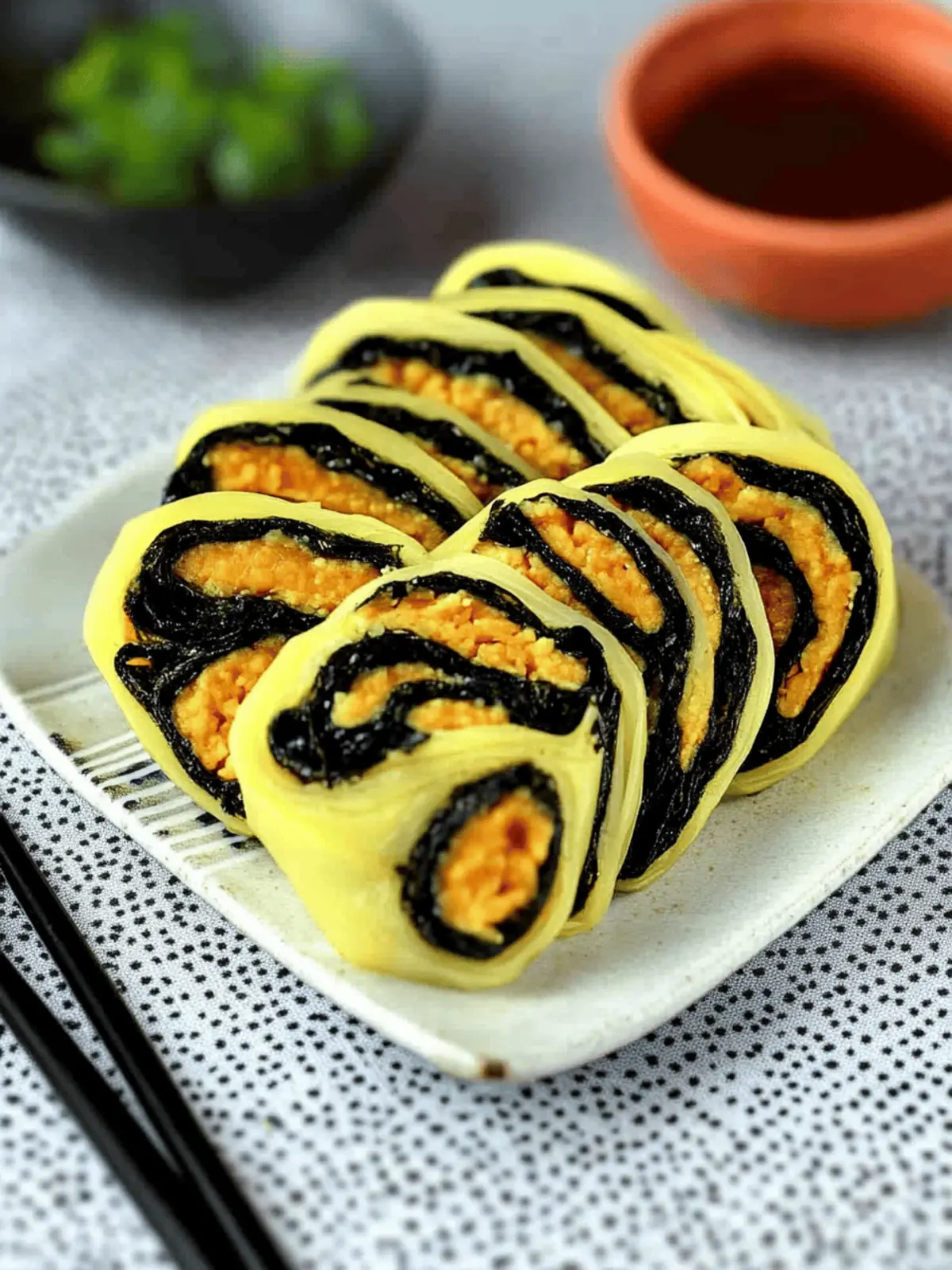
Delicious Korean Egg Roll With Seaweed: Quick and Easy Recipe
Ingredients
Equipment
Method
- In a liquid measuring cup or bowl, whisk together the eggs and salt until well combined.
- Heat a 12-inch non-stick pan over medium heat and swirl in the avocado oil.
- Pour in half of the egg mixture, rotating the pan to ensure an even layer, and cook for about 1-2 minutes.
- Place one sheet of roasted seaweed on the eggs when the bottom is set but the top is still moist.
- Start rolling the egg and seaweed from one edge and push to the edge of the skillet.
- Pour the rest of the whisked egg mixture into the pan to form another layer.
- Once set, lay the second sheet of roasted seaweed over the fresh egg layer.
- Roll up the entire egg omelet again from the edge of the cooked roll.
- Transfer to a cutting board, slice into bite-sized pieces, and serve warm with kimchi.

